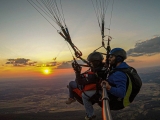If we practice winter sports, we must bear in mind that eye care is crucial, as the sun can damage our vision. Light is divided into three wave ranges: ultraviolet (UV), visible light, and infrared (IR). Ultraviolet rays are harmful, and although mostly absorbed by the atmosphere, the lower density at high altitudes and the snow's reflection make them dangerous. Within UV rays, there are three groups: UVA, UVB, and UVC—the latter, with the shortest wavelength, being the most harmful.

Visible light, as the name suggests, is the only type we perceive and thus what bothers us when intense (unlike UV or IR). Protection is necessary for comfort.
Infrared rays act through the heat they emit, and although the eye naturally absorbs IR thanks to its water content, the cornea can still be damaged.
It's worth noting that cloudy skies don’t block UV rays, and since they’re invisible, one might be tempted to go without goggles, as visible light is reduced and doesn’t "cause discomfort."

Some people are more photosensitive than others, and a few may "endure" being without goggles even in bright conditions, but the harm to their eyes is inevitable if unprotected. Symptoms after a few hours without goggles are highly unpleasant—a feeling of "grit in the eyes," stinging, and constant tearing.
A lack of protection can lead to snow blindness and temporary vision loss, even irreversibly damaging the cornea and conjunctiva, reducing visual acuity.
Given these harsh conditions, take care of your eyes. Invest in good goggles—when I say good, I don’t mean fashionable or overly "galactic." What matters in goggles is their lenses, and you can always find "cool" goggles with high-quality lenses.

Pay attention to the labels on the lenses. Don’t buy goggles without clear manufacturer indications and guarantees about their filtering capabilities. Good lenses must block 100% of UV rays—remember, these are the most harmful. For visible light, they should absorb between 85% and 95%, depending on the conditions you’ll face or your light sensitivity. IR rays should be filtered at least 50%, though higher (up to 90%) is better.
For high-altitude use, they must protect the eyes so light doesn’t excessively enter from the sides, either with added shields closing the gap near the temple (so-called glacier goggles) or through the goggles’ own wraparound design that fits the face’s contours.












